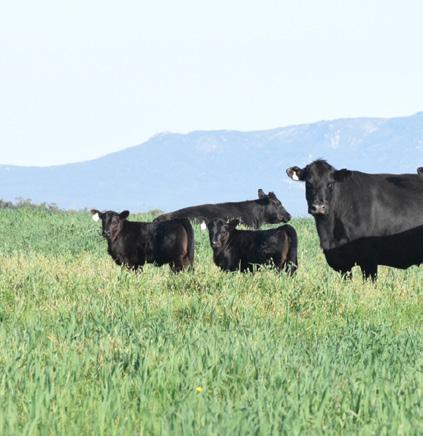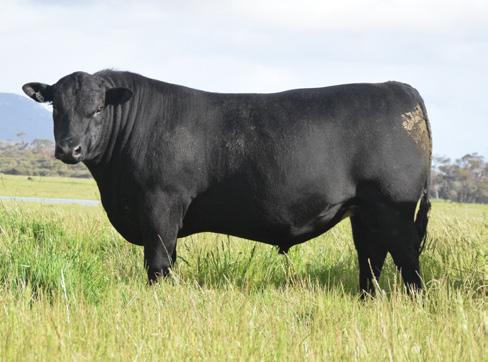
5 minute read
Growing with Angus in the West
Cheyne Twist, Senior Marketing & Communications Officer
While the west truly is its own frontier, Chris Metcalfe and his family are well placed and are forging ahead within the agricultural industry.
Chris Metcalfe calls Manypeaks on the South Coast of Western Australia home. Alongside his parents Richard and Christine and brother Tim, Chris operates a mixed enterprise over approximately 4,000 arable hectarage on predominantly sandy loam duplexes. Seasonally the area sees 650-750mm annual rainfall. With a history in the industry dating back three generations, the Metcalfe family run 1,500 breeding cows which includes the Koojan Hills Angus stud, Melaleuca Murray Grey Stud and a 700 head commercial herd. Their business is also diverse, with a 2,000 head Dohne ewe flock, mating them to White Suffolk rams to target the prime lamb market. “I am fortunate to be in business alongside my parents Richard and Christine and my brother Tim,” said Chris. “Richard is my mentor within the ag world and is an exceptional cattleman with a brilliant mind for business strategy. My brother Tim is an extremely dynamic farmer and is pushing the boundaries particularly in terms of pasture production.” In 2015 the Metcalfe’s purchased the Koojan Hills Angus stud, which was founded by Kojonup cattleman and past Angus Australia president, the late Lew Smit OAM. “We purchased the Koojan Hills herd off the late Lew Smit in 2015. Up until that point we had been a Murray Grey herd,” said Chris. “The opportunity to carry on Lew’s life passion for breeding cattle is a real honour and one I don’t take for granted.” The Metcalfe’s herd is comprised of 50% pure Angus, with their commercial herd predominately Murray Grey cows mated to Angus bulls. “We find this cross to be working exceptionally well for our target markets as we’re able to combine the muscling of our greys with the softness of the Angus,” said Chris. Each year the Metcalfe’s seedstock programs supply approximately 170 bulls to the local market. With an autumn calving herd, the Metcalfe’s utilise a nineweek joining period, with heifers joined at 15 months of age and at a minimum of 320kg. In 2022 they joined approximately 1,700 cows including 330 heifers. Aiming for an 80-90% PTIC success rate, the Metcalfe’s typically retain and mate 45% of their heifer drop. Identifying the key drivers of production and success for their herd as ease of calving, growth and carcase quality, the Metcalfe’s take into account firstly phenotype and maternal traits, and then hone in on the EBVs that further assist in consistently meeting their breeding objectives for their target markets. “Phenotype is our priority when selecting genetics as well as ensuring strong maternal backgrounds. In terms of EBV’s we target above average growth and EMA but are happy with breed average for most traits,” said Chris. “We look very closely at docility and foot EPD’s for American sires which is not always foolproof, but we find is usually a very good guide.” Their bull selection criteria considers program type, environment/management, pedigree, phenotype and EBV’s, ensuring that when selecting bulls for their herd they are choosing a package best suited not only genomically and phenotypically, but are well fitted within their breeding program and management style. “It’s always very disappointing culling great looking animals for feet or temperament so we do our best to get this right when selecting sires.” In their Koojan Hills herd, the Metcalfe’s utilise considered artificial insemination (AI) and embryo transfer (ET) programs, highlighting the ability to accelerate genetic gain in their operations.

“I feel as a seed stock producer it is our role to provide new/ elite genetics that benefit our commercial clients while being careful of not chasing fads and extremes that will be detrimental in the long term or using unproven genetics simply to be a point of difference in a sale catalogue,” said Chris. “I look up to the breed leading Angus studs who are very successful at backing their own program and prioritise their own bulls for AI/ET. A goal of mine is to emulate these breeders and to confidently back our top herd bulls to perform in our program as well or better than most of the popular AI sires.” In the lead up to, during and after joining, the Metcalfe’s take care to apply nutrition management to their cow herd. “Our focus is simply on providing a rising plane of nutrition leading into mating with plenty of fibre and trying to avoid running cows/heifers on the oestrogenic clovers which are prevalent in our area,” said Chris. “We use boluses in heifers to ensure trace elements and vitamins are at a suitable level with an emphasis on copper and selenium which we are lacking on the south coast of WA.” With phenotype a sticking point for the family, the female cull is culled on structure and feet, as well as temperament and coat type. “Structure and feet are a huge focus for us on the south coast. The softer county gives us the opportunity to be very hard on feet,” said Chris. “We love breeding thick, long, deep bodied cows that are slightly above average in frame with focus on udder quality, temperament, slick coat type. We will cull through the year according to this criteria, as well as progeny performance.” Participating in MSA grading, the majority of the commercial herd is bred for supermarkets, selling grassfed yearling steers and heifers to Woolworths and Coles to market specifications of 215kg-315kg cwt with 3-18mm P8 fat. Dependent on seasonal outcomes, the Metcalfe’s trade in steers through the winter and spring and finish them into the same market. When it comes to their management practices, the Metcalfe’s are reactive to their environment, but selective on genetics to respond to any environmental impacts. “Our beef enterprise is 50% genetics: 50% environment. Alongside genetic improvement we have a strong focus on grazing crops for our grass-fed program,” said Chris. “We utilise grazing canola’s in the summer and other summer forage crops to increase our overall kg beef/ha production, and it also allows us to access the premium market spots e.g., selling finished steers in the winter.” Considering their location in the most western regions of the country, the Metcalfe’s can face logistical challenges within their business. “Staffing is a challenge our business and industry is facing currently and will continue to face into the future, particularly in WA where the mining industry has such an enormous pull on the workforce. Another current challenge we are dealing with is supply chain issues for parts/equipment.” Looking to the future of their operations, the Metcalfe’s are currently in a position of change within their existing model and considering a recent expansion for their business are moving into a stage of development and growth for their herd.













